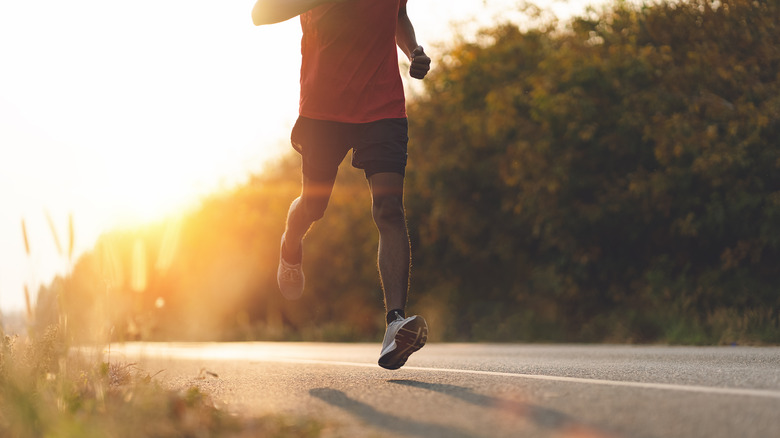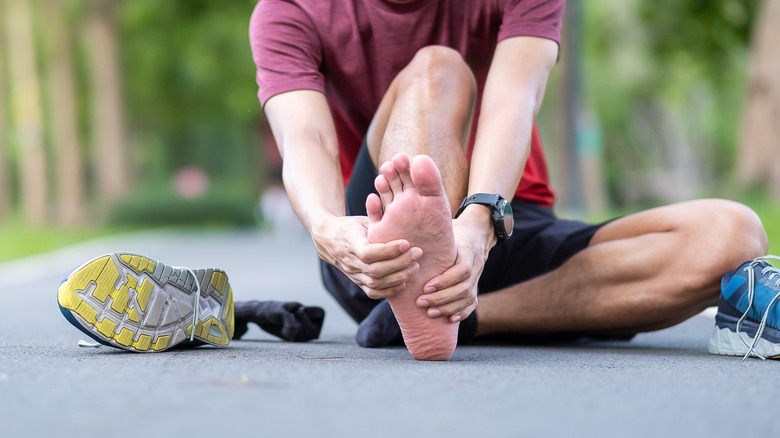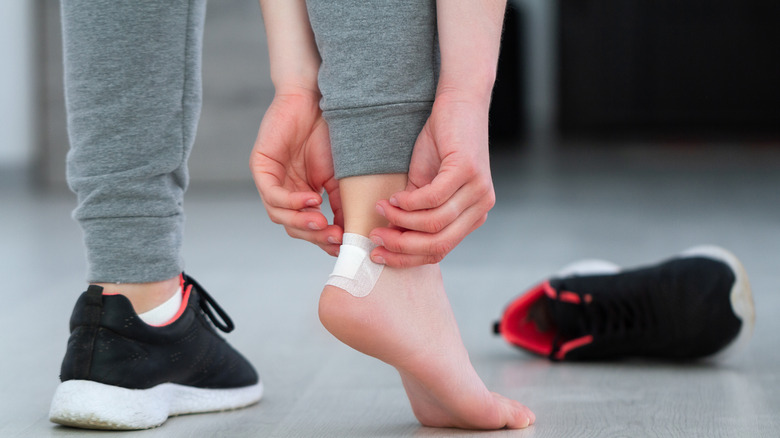Tips For Running When You Have A Blister
Blisters can form for many different reasons. When it comes to running they can develop from excessive friction, moisture, and perspiration. But blisters can also form when people skip out on wearing socks and by walk (or run) frequently in poorly fitted shoes, shares Cleveland Clinic. When this happens it can cause the layers of the skin to separate and the spaces to fill with fluid to prevent any further damage from happening, points out podiatrist Tony Gavin to Runner's World. These types of blisters are called friction blisters and the fluid is clear, explains Cleveland Clinic.
Besides friction blisters, there are two other types of blisters to be aware of: blood blisters and heat blisters. Blood blisters happen when the skin gets pinched and blood vessels are broken so blood pools into the area to form a blister (per Cleveland Clinic). These blisters can be red, black, or even dark purplish, explains Healthline. Alternatively, heat blisters are caused by sunburns, burns, or from warming up after frostbite (via Cleveland Clinic).
While blisters can heal on their own, they can be especially painful when running. Luckily, there are some ways to treat blisters for a smoother run. Below are some tips for running when you have a blister.
Caring for blisters while running
When caring for a blister it's important to make sure your hands are clean first. Gently wash the blister with a mild soap then dry it, and cover it with an antibacterial ointment, explains Cleveland Clinic. Next, you'll want to cover the blister with gauze or a bandage. Runner's World recommends using something that's breathable, waterproof, and offers more padding for your run such as blister-specific plaster.
If the blister is extremely painful, covering it with moleskin may also help ease the pain. In particular, cut a donut shape out of the moleskin and place the empty center directly on top of the blister then cover it with gauze, explains Mayo Clinic. This may help protect the blister and can provide some extra support for running.
However, sometimes blisters can get really full and pop up in less-than-ideal places. When this happens you may be wondering if it's safe to drain your blister. According to Healthline, never burst a blister, but draining it with a clean, sharp needle may help ease the pain. But before draining it, it's important to make sure your blister isn't infected. Talk to your doctor if you suspect an infection. In addition, Mayo Clinic recommends talking with your doctor before draining a blister if you have diabetes or poor circulation.
How to prevent future blisters
The next tips for running when you have a blister involve understanding the different ways to prevent them.
Believe it or not, the first line of defense for protecting your feet is your shoes. When shopping for running shoes, it's important to buy properly fitted shoes that don't rub your feet. Runner's World suggests looking at the fit, size, and type of shoe. Gavin explained to Runner's World to look for a shoe where the toe-box length and width match the natural form of your feet. This will give your feet ample room and may help ward off injury. Shoe insoles may also help, points out Healthline.
The next line of defense is your socks. Consider trying moisture-wicking socks or foot powder to help keep your feet dry, shares Healthline.
Finally, taping blister-prone areas may help prevent future friction blisters. One 2016 study published in the Clinical Journal of Sport Medicine reports that paper tape has the ability to prevent blisters in runners. Applying adhesive tape can lower the chance of blisters by 40%.
While blisters can be painful, keep in mind that they do heal on their own with time. Whatever stage your blister is at it's important to keep the area dry and consult a doctor if the blister seems infected.



